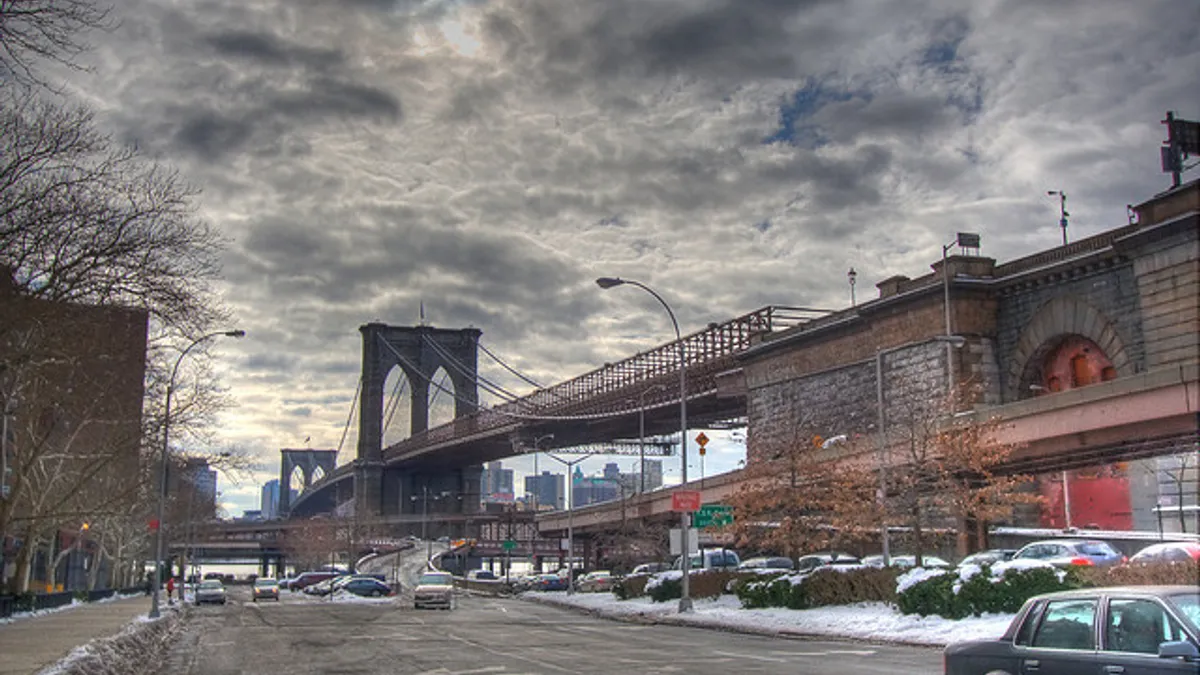UPDATE: Dec. 18, 2020: An appellate division of the New York State Supreme Court has upheld a lower court's 2019 decision to reject an appeal led by waste industry groups seeking to overturn New York City's "waste equity" law regarding transfer station capacity, as first reported by THE CITY.
In its Dec. 17 decision, the court said the city had conducted "an appropriate environmental review" in line with state requirements, found "the law was not preempted by state law" and "decided the forced waste capacity reductions do not violate any constitutional rights of petitioner transfer station owners." According to a recent report from the city's Department of Sanitation, the law led to a reduction of more than 10,000 tons of permitted capacity through Sept. 30 with the greatest reductions occurring in one northern Brooklyn district.
Dive Brief:
- December 2019: New York's Department of Sanitation (DSNY) has exercised its new authority under Local Law 152 of 2018 – known as the "waste equity" law – to cut 1,361 tons of daily permitted capacity at transfer stations. So far, this has affected three facilities in northern Brooklyn.
- "(This law) will substantially reduce permitted capacity in four communities historically overburdened by private waste management infrastructure," DSNY Director of Communications Belinda Mager told Waste Dive in a statement. "DSNY will continue to implement permit reductions upon annual permit renewal for the remaining 21 permits covered by the law through September 2020."
- While the National Waste & Recycling Association (NWRA) and multiple transfer station owners lost a challenge to the law in October, they filed a notice to appeal with the Appellate Division of the New York State Supreme Court in November. This keeps a limited window open if they choose to move forward.
Dive Insight:
The New York City Council's passage of the law last summer, buoyed by broader commercial waste reform sentiments, concluded a multi-year fight by environmental and community advocacy groups. Amid the closure of local landfills in prior decades, certain parts of New York saw an increase in the number of private transfer stations. Four communities in the Bronx, Brooklyn and Queens bore the highest concentration of these facilities, which advocates and city officials have described as an environmental justice issue.
DSNY now has the authority to reduce capacity at facilities in these areas by as much as 33% to 50% when permits come up for renewal. Mager described this to Waste Dive as an "important step" in completing implementation of the city's solid waste management plan, which prioritizes marine and rail transfer over truck-based facilities.
The first three affected sites accept a range of materials. One, owned by Allocco Recycling, takes construction debris. Another, owned by Waste Management, accepts MSW. Waste Management declined to comment on the capacity reduction other than to say it is in compliance. Estimates from a prior city environmental assessment statement indicate this facility may have seen the largest reduction of the three in tonnage, but not revenue. GPB Waste, which handles MSW and organics at the third site, declined to comment.
A source familiar with the GPB facility's operations told Waste Dive capacity has been cut from approximately 560 tons per day – a combined total for MSW and organics – to 336 tons. That change has resulted in the elimination of a shift, which is expected to lead to layoffs. Much of this tonnage and attendant truck traffic is likely to shift to a nearby rail transfer station run by Waste Management.
It remains unclear whether this will have any effect on a lawsuit filed by community group Cleanup North Brooklyn against GPB subsidiary Brooklyn Transfer LLC in 2017. The next court date in that case is scheduled for February 2020.
"While the lawsuit takes its time to move through the courts, the community members are thrilled that the Waste Equity Law will be the first significant effort to reduce the amount of waste handled at this facility," said Melissa Iachan, the group's legal counsel. "The facility still has a long uphill road of improvements to make before the many nuisances on the surrounding community are truly mitigated, but (Cleanup North Brooklyn is) hopeful that the Waste Equity Law will be a big step forward."
Many of the remaining facilities on DSNY's list – including sites owned by plaintiffs in the failed legal challenge – are expected to see similar or greater capacity reductions in the months ahead.
“We understand that the city won the lawsuit, but a lot of disposal capacity, both putrescible and C&D, will be taken offline," Steve Changaris, vice president of NWRA's Northeast region, told Waste Dive. "Those permits were fairly and legally obtained and they mean a lot of different things to different organizations that hold them. There are some family businesses that are highly dependent on those permits."
While some companies have already begun ramping down capacity in anticipation, it remains unclear if any will keep the legal challenge going. Multiple operators maintain they can run their facilities in a way that isn't burdensome to local residents and may feel compelled to fight. At the same time, many are also increasingly focused on the complex and uncertain process of bidding on commercial waste zones next year.















